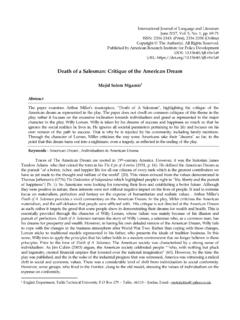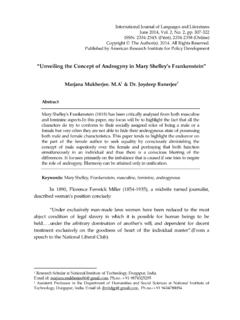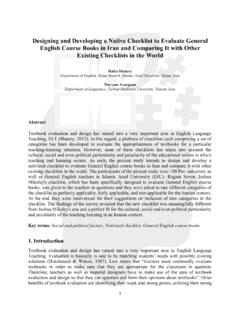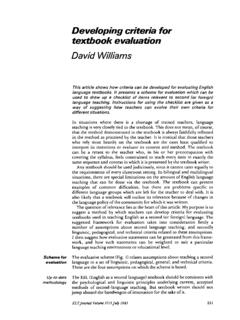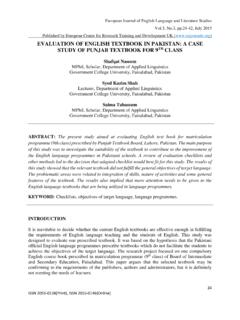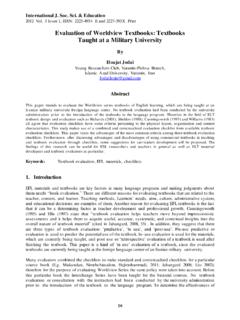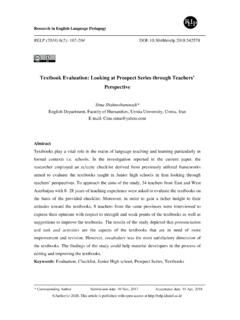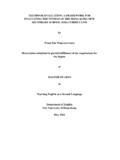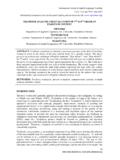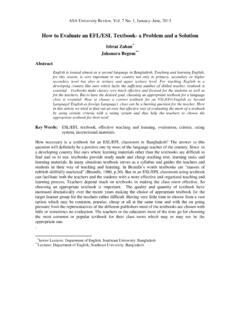Transcription of An Evaluation of Authenticity: A Case of EAP Textbooks in ...
1 International Journal of Languages and Literatures March 2014, Vol. 2, No. 1, pp. 91-113 ISSN: 2334-234X (Print), 2334-2358 (Online) Copyright The Author(s). 2014. All Rights Reserved. Published by American Research Institute for Policy Development An Evaluation of Authenticity: A Case of EAP Textbooks in Iran Zahra Zohoorian1 and Prof. Dr. AmbigapathyPandian2 Abstract Authenticity and authentic materials are advocated for language teaching extensively. This criterion is also recommended for English language teaching settings such as EAP where the students are to deal with real-world and authentic language use. The present study aims at evaluating the current status of the EAP Textbooks and the materials included in them in Iran by the administration of the authenticity Evaluation checklist . Accordingly, seeking to find data both qualitatively and quantitatively, the study was conducted to seek for the lecturers views on the authenticity level of the EAP Textbooks .
2 Thus, the results of the interview and the Evaluation checklist reveal that although authenticity of context, teacher, student, and text is deemed as essential by this group of teachers, the current Textbooks for EAP have limited authenticity and in some aspects authenticity is even absent. The interview results revealed that the majority of the EAP teachers believed that the current EAP Textbooks need to be reengineered and the texts need revision. Thus, the findings can be used by EAP curriculum designers and materials developers in taking into consideration the authenticity feature as an important factor in designing EAP Textbooks in future in Iran and in similar language teaching contexts. Keywords: authenticity; context authenticity; student authenticity; teacher authenticity; content authenticity 1 Introduction Materials included in every course have a focal role and their careful selection may facilitate the teachers in making choices, considering alternatives, and planning for learner needs (Celce-Murcia, 2000).
3 1 PhD candidate at University Sains Malaysia; Full-time faculty member at Department of Languages, Islamic Azad University, Mashhad Branch, Mashhad, Iran. Hand phone: 0060169927220, E-mail: 2 University Sains Malaysia 92 International Journal of Languages and Literatures,Vol. 2(1), March 2014 As Shomoossi and Ketabi (2007) maintain, hitherto, syllabus designers and materials developers basis was on how of arranging materials and activities and authenticity did not play any role. However, nowadays as Khaniya (2006, ) maintains: In the course of the decade, the use of authentic materials has become increasingly popular in learning situations ranging from traditional intensive ESL to language training for professionals. Particularly in the latter setting (teaching language for professionals), Khaniya believes that a larger number of teachers are starting to identify the benefits of authentic materials and the options that such texts may provide.
4 Considering materials preparation for EFL contexts, Graves (2000) believes that materials must be chosen based on their authenticity principle so that the students get familiar with and have access to language as it is used in real world. As Horwitz (2008) points out, in specialized courses (for example EAP) learners have a range of needs and purposes which play an important part in preparing materials. One of the needs and purposes in ESP/EAP courses is to act properly and effectively in real-world situations and out of the instructional context (Dudley-Evans & ST John, 1998; Harding, 2007). To fulfill this need, it seems that the exposure of the learners to authentic materials and providing an authentic language learning setting may have positive effects. Authenticity Authenticity was initially introduced over a thousand years ago by King Alfred of England who commenced the use of authentic texts for educational purposes.
5 Later, in the 16th century Roger Ascham and Michel de Montaigne portrayed the use of authentic approaches for teaching Latin (Mishan, 2005). In the 19th century (1890s), Henry Sweet approved authentic texts and asserted that natural texts do justice to every feature of the language ; on the other hand, artificial materials include repetition of certain grammatical constructions, certain elements of the vocabulary, certain combinations of words to the almost total exclusion of others which are equally, or perhaps even more essential (Gilmore, 2007). Zohoorian & Pandian 93 Authenticity reappeared again during 1960s and 1970s as a consequence of Chomsky and Hymes discussions of communicative competence which stated that communicative competence does not only encompass the knowledge of the language but comprises the need for contextualized communication (Mishan, 2005; Gilmore, 2007).
6 Thus, communicative language teaching was the highpoint of this view (Gilmore, 2007; Guariento & Morley, 2001; Lin, 2004). However, the concept and its applications and the belief that for diverse language teaching settings authenticity has demonstrated its valuable role is still pointed out by the 21st century scholars such as Shrum and Glisan (2000), Richards (2001), Kilickaya, (2004), Mishan (2005), Khaniya (2006), Gilmore (2011), etc. Authenticity has also played a central role for materials developers, syllabus designers as well as some approaches to language teaching such as task-based (Bax, 2003), communicative language teaching (Bax, 2003; Mishan, 2005), and humanistic, autonomous, and materials-based approaches (Mishan, 2005). As Shomoossi and Ketabi (2007) maintain, hitherto, syllabus designers and materials developers basis was on how of arranging materials and activities and authenticity did not play any role.
7 However, currently as Khaniya (2006) maintains during the present decade, authentic materials are increasingly being used in various language teaching situations which may range from traditional ESL courses to language teaching for professionals. Particularly in the latter setting (teaching language for professionals), Khaniya believes that a larger number of teachers are starting to identify the benefits of authentic materials and the options that authentic texts may provide. Thus, authenticity as a notion has been with language teaching literature since a long time ago and it has been considered by several scholars to date. Authenticity is viewed by different scholars diversely. Rogers & Medley (1988) use the term authenticity as used for describing oral and written language samples which reflect language forms and are used naturally and appropriately in cultural and situational contexts. On the other hand, others such as Berardo (2006) remark that authenticity is the interaction that is established between the text and the reader.
8 Berardo views authenticity as a continuing process which is beyond the context of the text . For this, the way the students read texts must match their purpose of reading, the text kind, and the way people read texts in normal contexts. Ur (1984, cited in Celce-Murcia, 2000) refers to the term as being either genuine authenticity or imitation authenticity. 94 International Journal of Languages and Literatures,Vol. 2(1), March 2014 Genuine authenticity is the natural interaction which takes place among native speakers and imitation authenticity refers to real speech but with the consideration of learners language level and ability. Breen (1985) introduces four types of authenticity including text authenticity learners interpretation authenticity , task authenticity and situation authenticity . Text authenticity is concerned with text qualities as a source of data which will support the learner in the development of an authentic interpretation.
9 Learner interpretation authenticity refers to the learner s understanding of the target language conventions which leads to the interpretation of the meaning embedded in the text. Task authenticity refers to the authenticity of the language learning drive for which the input is used. The authenticity of the classroom and the actual social situation of the learning context are concerned with the environment in which learning takes place. It includes the provision of conditions under which the learners can share achievements, problems and learning. All in all, Breen concludes that bringing authentic and real world into the classroom cannot be the essence of what is meant by authenticity unless all the four types of authenticity are provided. Subsequent to that idea, as Taylor (1994) discusses, criticisms which are put forward against inauthenticity or artificiality of materials perhaps do not take into account Breen s classification and they assume that there is a global and absolute definition of authenticity but as far as Breen s authenticity types are concerned there exist no such things as truly artificial or inauthentic materials.
10 But authenticity is clearly a relative matter and different aspects of it can be present in different degrees. Another classification of authenticity which also shares Breen s classification ideas is offered by MacDonald and colleagues (2006). These include authenticity of text, authenticity of competence, learner authenticity and authenticity of classroom. For the first kind, text authenticity, we may encounter terms such as language authenticity or materials authenticity. For the second kind of authenticity, competence authenticity, it may be referred to Canale and Swain s 1980 classification of competence which has three categories of grammatical competence (knowing all rules of grammar), sociolinguistic competence (knowing appropriate register and style), and strategic competence (being aware of the compensation strategies used for breakdowns in communication).
